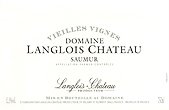Lots of red hearts, two elegant whites, one burning question
 My tech-writing friends Susan and Frank had me over for a very special dinner on Sunday. I had brought chocolate-orange hearts and a bottle of Château Haut-Bertinerie Premières Côtes de Blaye 2000 (below), a sophisticated Bordeaux from a stellar year. It was made uniquely from Sauvignon Blanc and harvested from vieilles vignes.
My tech-writing friends Susan and Frank had me over for a very special dinner on Sunday. I had brought chocolate-orange hearts and a bottle of Château Haut-Bertinerie Premières Côtes de Blaye 2000 (below), a sophisticated Bordeaux from a stellar year. It was made uniquely from Sauvignon Blanc and harvested from vieilles vignes.
But from out of the fridge, Susan was handling another serious white: the
Vieilles Vignes du Domaine Langlois-Château Saumur 2002 (right), a Chenin Blanc varietal benefiting from the Loire's more recent spectacular vintage.
It was an embarrassment of riches. And seeing as I earlier recommended that Frank pick up the Langlois while it was on sale, I was asked to make the choice. Which should we open first? I knew they were baking trout and that they had prepared a salad to start, but the fourth dinner guest had not yet arrived. We would need a nice aperatif now. I had had the Langlois as a aperatif before. I was among other friends at the time and none of us was very familiar with Chenin Blanc. We were a bit perplexed by its off-dryness and I thought that a grape with such body would do well with some rich food. Susan and Frank's fish was prepared without a sauce -- the richness that Chenin gravitates to -- and instead topped by herbs and caviar, but a lovely rich scalloped potato dish perfumed the room and it was signaling a potential pairing. So I opted to save the 2002 Chenin and go for the older, drier Bertinerie to start.
I had had the Langlois as a aperatif before. I was among other friends at the time and none of us was very familiar with Chenin Blanc. We were a bit perplexed by its off-dryness and I thought that a grape with such body would do well with some rich food. Susan and Frank's fish was prepared without a sauce -- the richness that Chenin gravitates to -- and instead topped by herbs and caviar, but a lovely rich scalloped potato dish perfumed the room and it was signaling a potential pairing. So I opted to save the 2002 Chenin and go for the older, drier Bertinerie to start.
It was an immediate hit. It tasted even better than I remembered. Vineux, deep tones, excellently balanced. Yes, some Sauvignons can come across this confidently in room full of Chenins and Chardonnays. That 2000 vintage really was remarkable.
Nevertheless, as I drank my aged Sauvignon, I thought that a 2002 Chenin would prove to be no slouch either, and besides, it was not that much younger anyway. While it is rare to progress to younger bottles during a flight of wine, I remained sure of my ordering. The hosts, upon opening their Saumur, were not. They liked the Loire Langlois for its exotic, fruity aromas and noted its superb consistency, but Susan was a straight-shooter: "I'd have to argue that this kind of wine would do so very well on its own, while the smokiness of the Bordeaux would've been an excellent match with the fish."
She was absolutely right on this -- the oak in the Bertinerie was practically custom-made for her oven-cooked trout. Myself, I felt from the first sip of the Saumur that the difference in age actually was palpable, even though only two years separated them. Impossibly, the Chenin seemed lighter and more youthful than the Sauvignon, making my decision on which was the more alluring aperatif a bit off-base. Furthermore, thought the Bertinerie was indeed wonderful to enjoy on its own, when it was followed by the Langlois, the added sweetness of Chenin was not announced as loudly as I was expecting. I could have -- and should have -- reversed them. My worry of progressing to a sweeter wine was clearly unfounded.
But it was a great dinner with great wines -- no real complaint could be made. Instead, what could be made are orders for more of the Bertinerie, to be served with another meal of delicious fish.







No comments:
Post a Comment